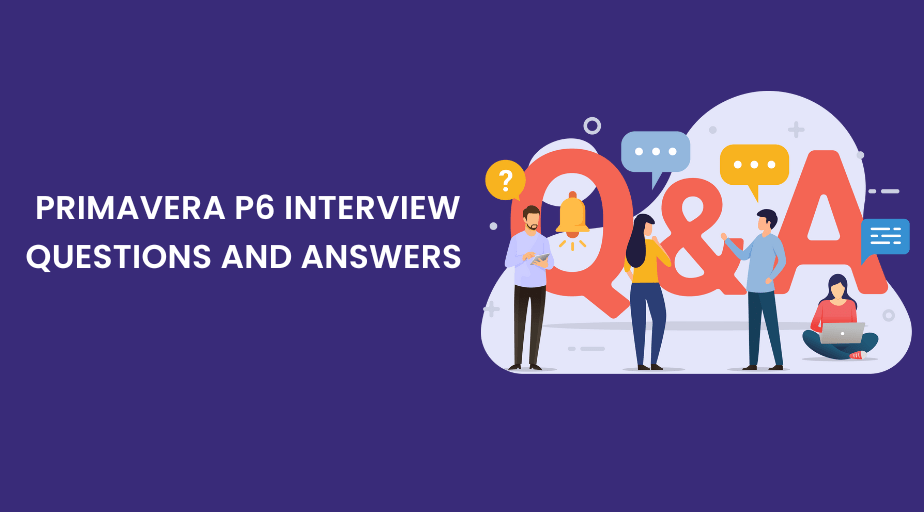Do you want to start a career in project management, or are you looking to upgrade your skills? Taking a Primavera Course can be a great option. Primavera P6 is one of the world’s most widely used project management software applications, and mastering its features and functionalities can open up new career opportunities. In this blog, we provide some of the most common Primavera P6 interview questions and answers to help you prepare for your upcoming interview after completing a Primavera course.

Table of Contents
- Interview Questions and Answers
- Conclusion
Interview Questions and Answers
Q: What is Primavera P6?
Ans: Primavera P6 is a project management software application that helps organizations manage their project portfolios effectively. It is a comprehensive, multi-project planning and control software.
Q: What are the different types of activities in Primavera P6?
Ans: The different types of activities in Primavera P6 are:
- Task Dependent Activities
- Resource Dependent Activities
- Level of Effort Activities
- WBS Summary Activities
Q: What is a WBS in Primavera P6?
Ans: WBS stands for Work Breakdown Structure. It is a hierarchical decomposition of the project into smaller, more manageable components. WBS in Primavera P6 allows project managers to break down the project into smaller components, making it easier to manage.
Q: What is a Baseline in Primavera P6?
Ans: A Baseline in Primavera P6 is a snapshot of the project plan at a specific point in time. It is used as a reference point to track progress and measure performance against the plan.
Q: What is a Resource in Primavera P6?
Ans: A Resource in Primavera P6 is anything required to complete a task. Resources can be labor, equipment, materials, or anything else needed to complete a task.
Q: What is the critical path in Primavera P6?
Ans: In Primavera P6, the critical route is the longest series of activities that defines the total length of the project. The critical path will ensure the project’s completion date is on time.
Q: What is a milestone in Primavera P6?
Ans: A milestone in Primavera P6 is a significant event or achievement in the project. It is a point in the project that marks the completion of a major deliverable or the start of a significant phase.
Q: What is the difference between a Constraint and a Deadline in Primavera P6?
Ans: A Constraint in Primavera P6 is a restriction placed on the project schedule, such as a specific start or finish date. On the other hand, a deadline is a target date that the project team is working towards.
Q: What is the purpose of the Earned Value Management (EVM) technique in Primavera P6?
Ans: The purpose of the Earned Value Management (EVM) technique in Primavera P6 is to measure project performance against the project plan. It helps project managers to track the project’s progress, identify potential problems, and take corrective action if necessary.
Q: How does Primavera P6 help in resource leveling?
Ans: Primavera P6 helps in resource leveling by identifying over-allocated or under-utilized resources and providing options to re-assign or adjust the resources to balance the workload across the project schedule.
Q: What is the purpose of the Global Change feature in Primavera P6?
Ans: The purpose of the Global Change feature in Primavera P6 is to simultaneously apply changes to multiple project activities. It is a powerful feature that helps project managers to save time and effort by making bulk changes to the project schedule.
Q: How can you track project progress in Primavera P6?
Ans: Project progress in Primavera P6 can be tracked by comparing the actual project performance data against the project baseline. This can be done using techniques such as Earned Value Management (EVM), progress tracking, and performance analysis.
Q: What is the purpose of the Scheduling Options in Primavera P6?
Ans: The purpose of the Scheduling Options in Primavera P6 is to control how the project schedule is calculated and displayed. It allows project managers to customize the project schedule based on their specific needs and preferences.
Q: How does Primavera P6 help in risk management?
Ans: Primavera P6 helps manage risks by providing tools to identify, assess, and mitigate project risks. It allows project managers to create risk registers, assign risk ownership, and track risk response plans.
Conclusion
Primavera P6 is a powerful project management tool that organizations worldwide use. In order to prepare for a job interview in project management, it is essential to be familiar with Primavera P6 and understand its key features and functionalities. Reviewing the common interview questions and answers provided in this blog will prepare you for your upcoming interview and increase your chances of securing the job.





